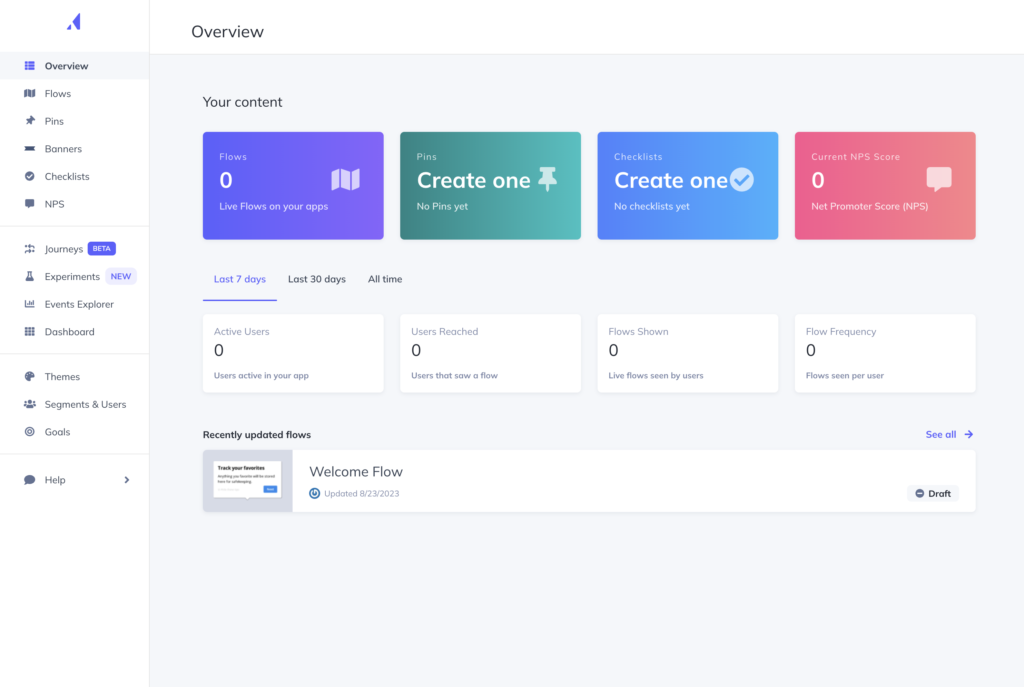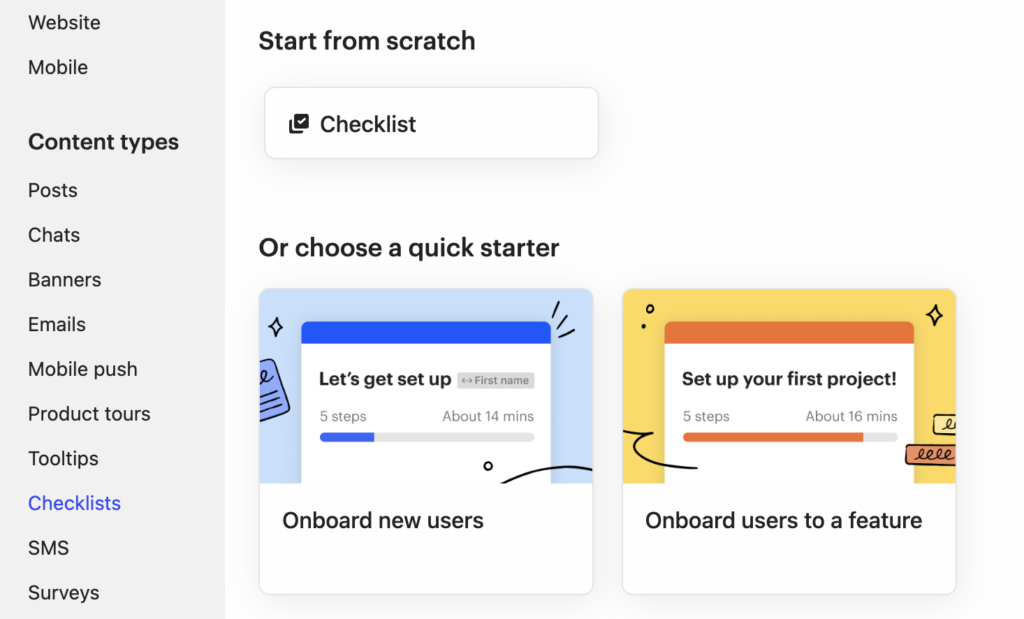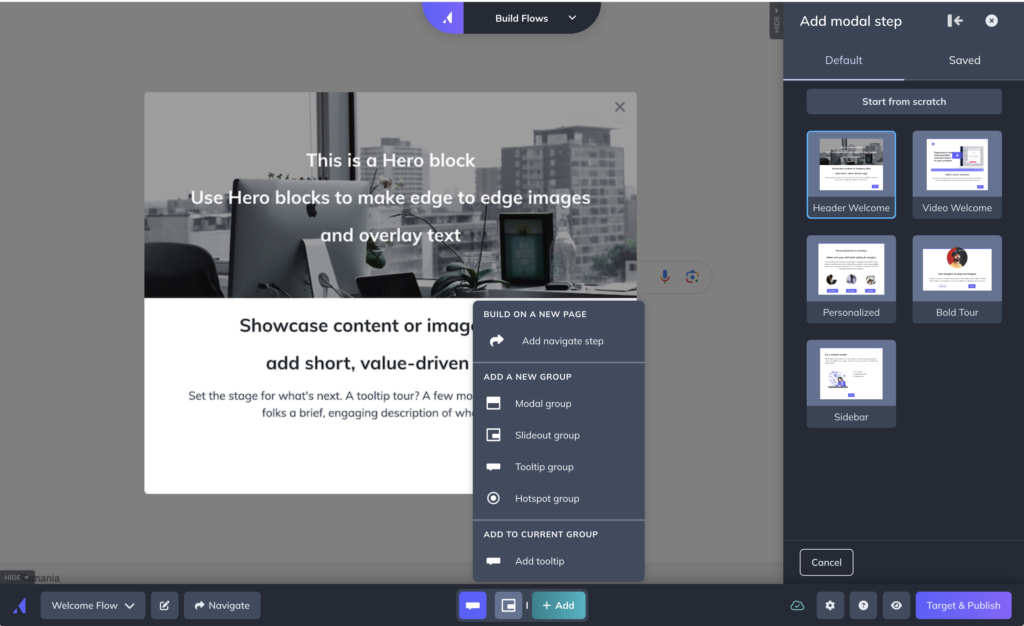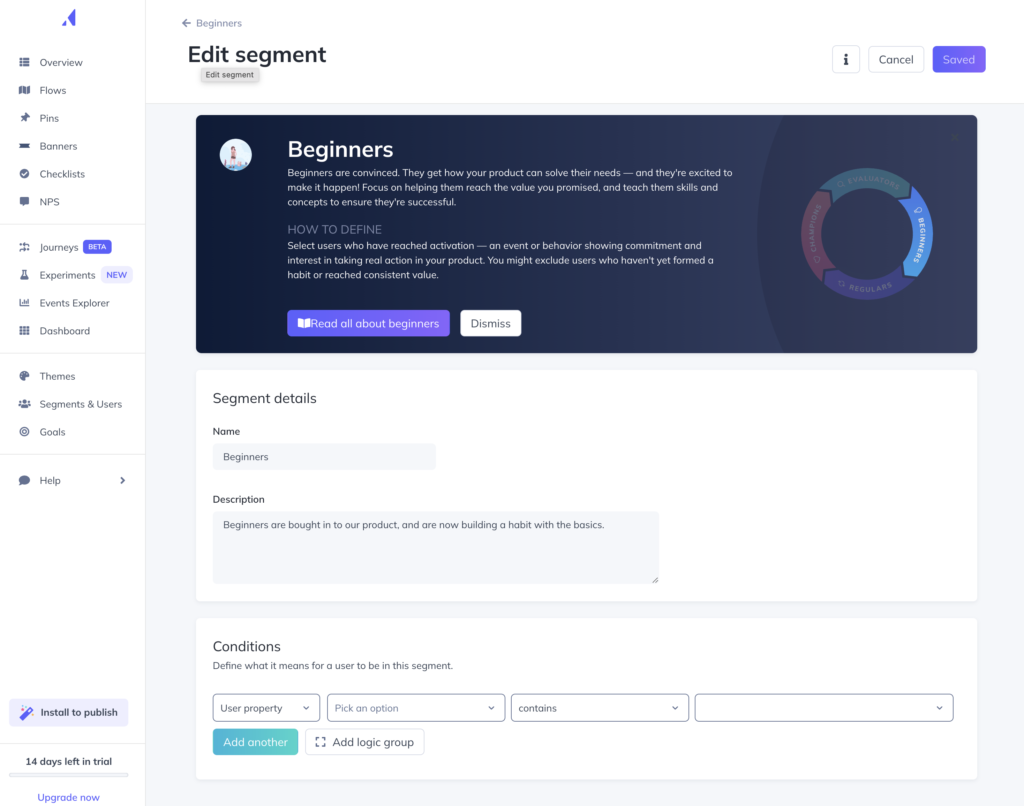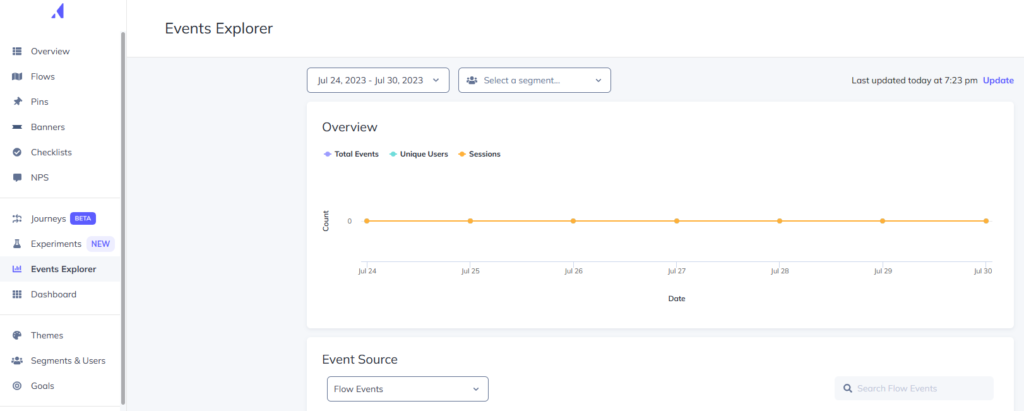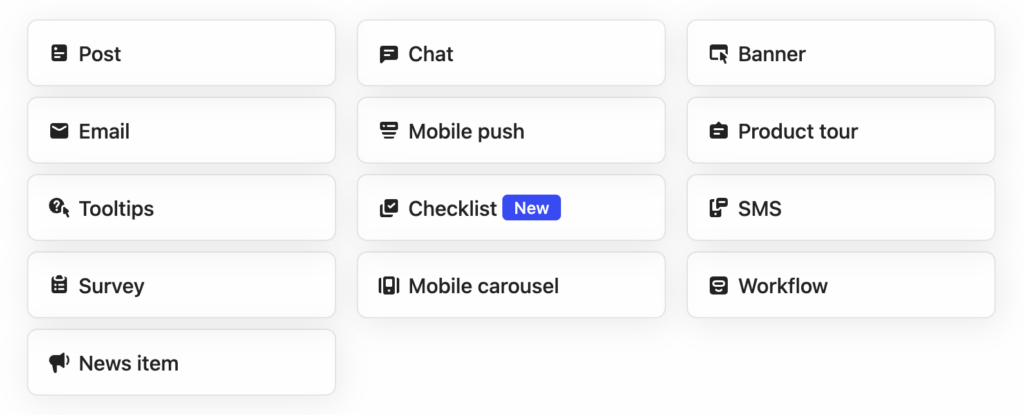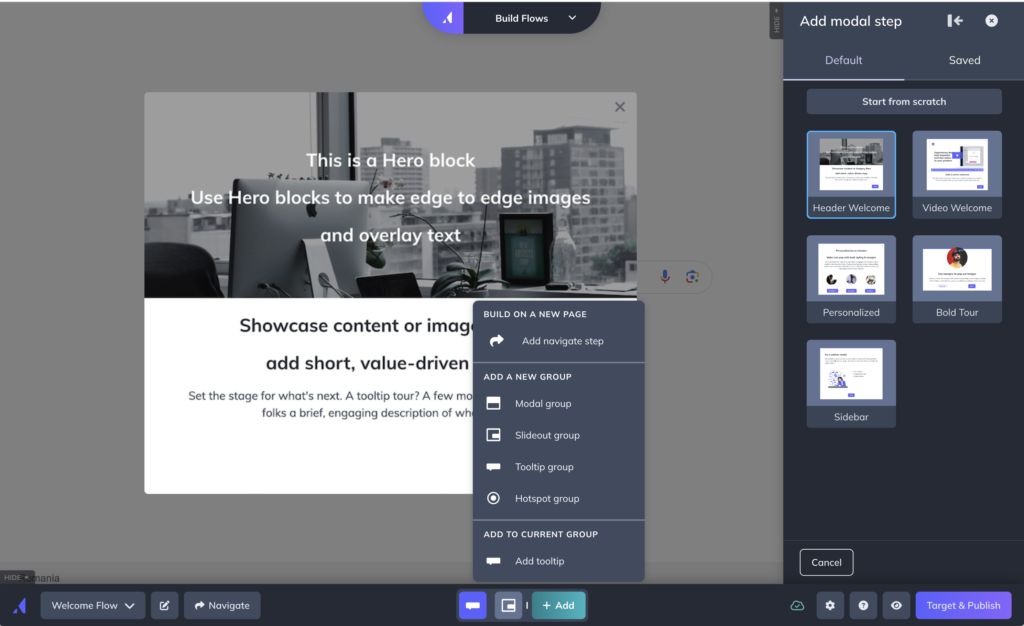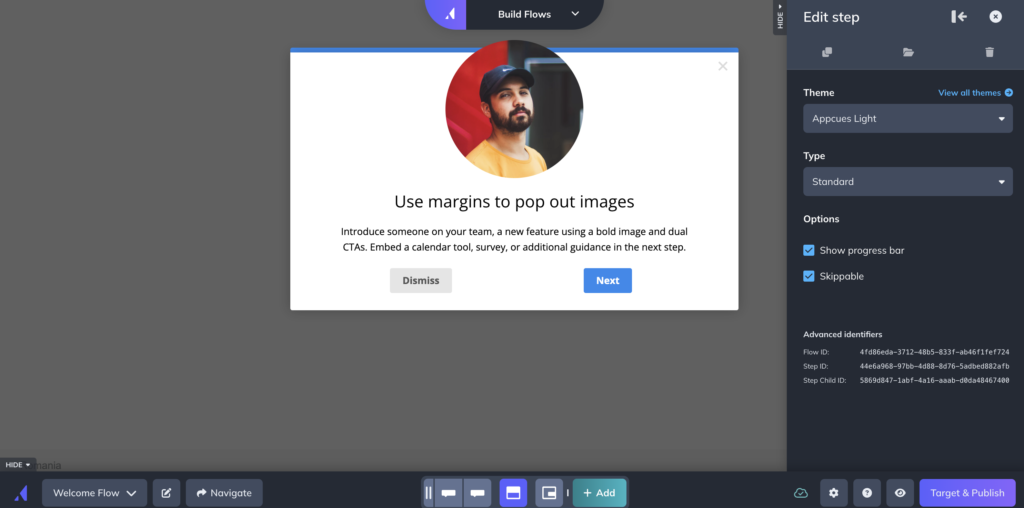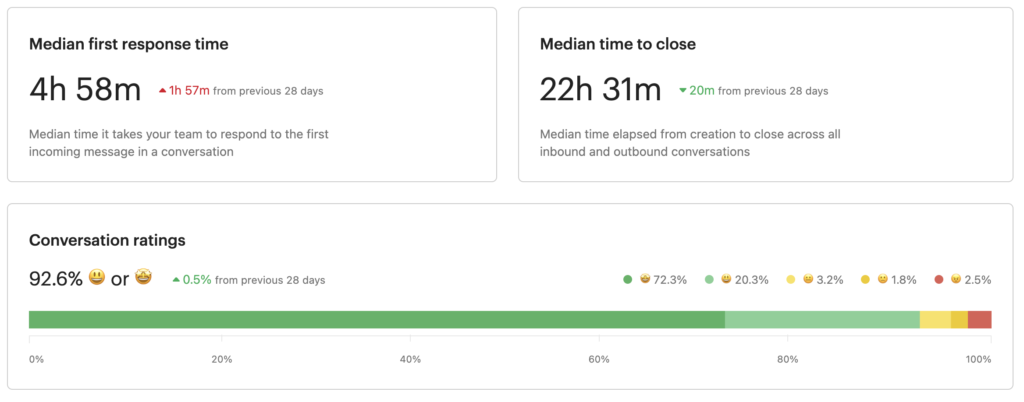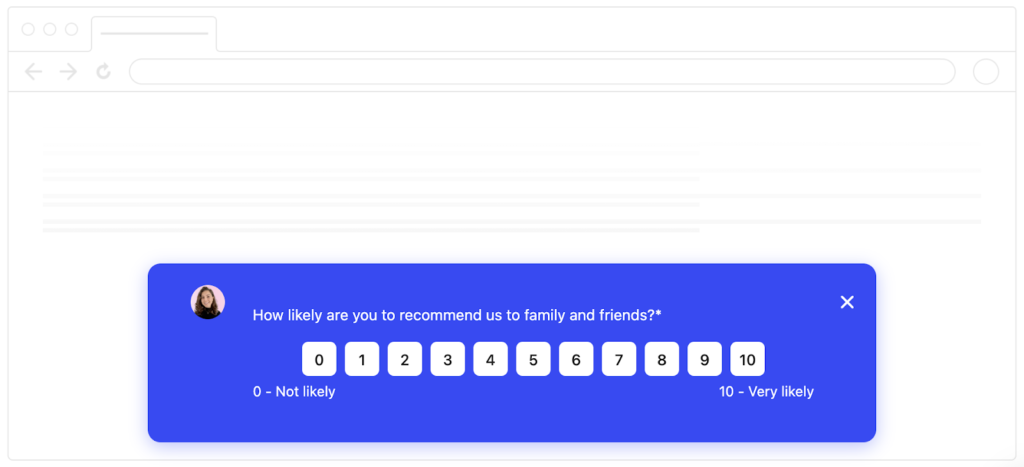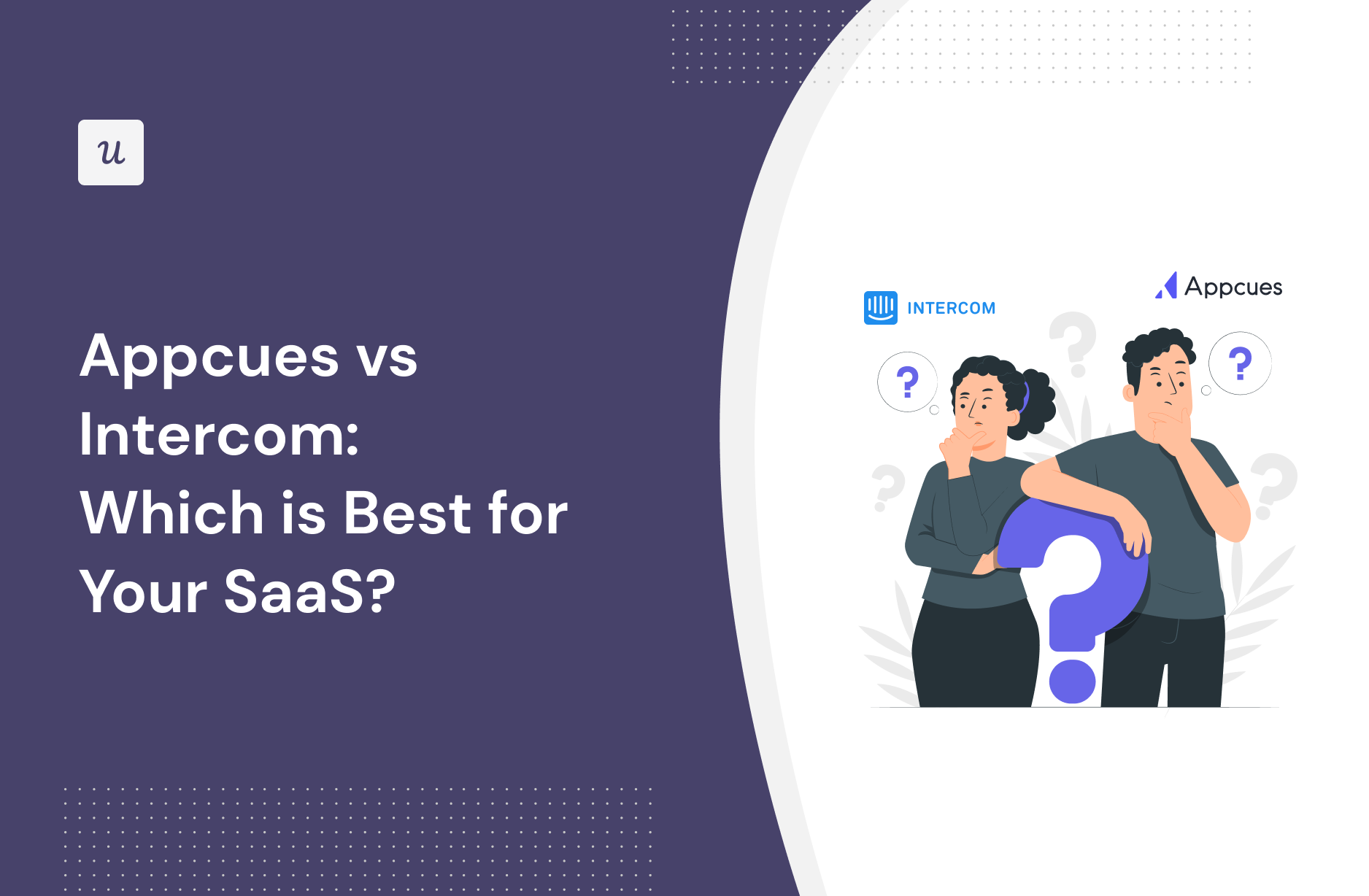
Wondering whether Appcues or Intercom is the best option for your SaaS company?
This article is going to dive into the Appcues vs Intercom debate and try to answer a key question: Which is the better tool for user onboarding, as well as other use cases?
In the post below, we’ve covered all the common use cases and done an in-depth analysis of the key features of Appcues and Intercom – as well as compared it to an alternative solution that may be better in some situations.
Let’s get into it!
Try Userpilot Now
See Why 1,000+ Teams Choose Userpilot

Overview of Appcues vs Intercom
- Let’s explore how Appcues, and Intercom compare when it comes to user onboarding and other common use cases.
-
- Appcues is a robust product adoption and user onboarding platform for web and mobile apps. It enables product teams to create, implement, and test personalized in-app onboarding experiences. The platform also helps you announce new product features and collect customer feedback.
- Intercom is a customer service platform. It offers customizable live chat widgets, omnichannel support capabilities, and integrations with over 300 apps. While Intercom is primarily a support solution, it does have add-ons that offer other functionalities such as product tours.
-
- If you’re looking for a better option for user onboarding, Userpilot exceeds both functionality and value for money compared to other tools on the list.
- Userpilot is a product growth platform that drives user activation, feature adoption, and expansion revenue. It also helps product teams collect user feedback, streamline onboarding, and gather actionable insights from analytics. Get a Userpilot demo for user onboarding and drive your product growth code-free.
What is Appcues?
Appcues is a robust product adoption and user onboarding platform for web and mobile apps. It enables product teams to create, implement, and test personalized in-app onboarding experiences. The platform also helps you announce new product features and collect customer feedback.
What makes this platform even better is the fact that it offers no-code features that make it suitable for non-technical teams.
What is Intercom?
Intercom is a customer service platform. It offers customizable live chat widgets, omnichannel support capabilities, and integrations with over 300 apps. While Intercom is primarily a support solution, it does have add-ons that offer other functionalities such as product tours.
The Product Tours add-on contains features that aid onboarding, adoption, and feature discovery. Intercom’s product tours can include UI patterns like modals and tooltips as well as other media formats such as microvideos.
Appcues vs Intercom for user onboarding
In this section of the article, we’re really going to compare Appcues vs Intercom in terms of user onboarding. That way, we’ll be able to figure out which tool – Appcues or Intercom – is the best option depending on your use case.
Appcues for user onboarding
Onboarding new users seamlessly is one of the primary use cases of Appcues. The platform offers a wide array of features to help you improve user activation, conversion, and retention.
Let’s take a closer look at how Appcues facilitates new user onboarding:
- Drag-and-drop builder: Appcues’s no-code builder lets you create personalized onboarding tours and checklists to assist and educate new users. You can customize UI patterns like hotspots, modals, slideouts, and tooltips to guide users.
- In-app user guides and product tours: You can use various UI patterns, such as hotspots and tooltips, to introduce new users to product features in a pre-defined sequence. Similarly, you can use checklists to guide users as they explore your app.
- Checklists: You can also create checklists with Appcues (NOT available on the Essentials plan) and prompt users to take action. These are ok but have limited functionality (you can’t trigger JS functions or add gamification elements) compared to alternatives, such as Userpilot.
- Segmentation: You can use one of the pre-defined audience segments or create customer segments based on plan tier, lifecycle stage, and other factors. It’s possible to target individual segments with personalized messaging and journeys.
- Measure and improve: You can track in-app flow performance and measure events (limited to 5 on the Essentials plan) to identify areas of improvement.
- Test and optimize: The newly introduced A/B testing feature lets you test different onboarding flows. You can compare the performance of different in-app sequences, identify the best-performing ones, and refine onboarding flows.
Intercom for user onboarding
User onboarding educates new customers, teaches them how to use your product, and helps them get the most value in the least amount of time.
Intercom’s Product Tours add-on includes UI patterns and onboarding analytics that can prove helpful (if you’re willing to pay extra for them).
This will cost you an additional $199/month on top of what you’re currently paying for your base Intercom subscription. This puts its pricing on par with dedicated onboarding/adoption tools despite lacking feature parity.
Here’s an overview of Intercom’s Product Tours add-on:
- UI Patterns: Intercom’s product tours for onboarding come with an expansive selection of UI patterns like tooltips, banners, surveys, in-app checklists, and multi-step flows. You can also use communication features in your tours such as SMS messages or live chat widgets.
- Onboarding Analytics: Intercom shows you detailed analytics for each product tour such as the total number of views, overall completion rate, percentage of users who achieved a particular goal, and how many issues were encountered during the tour.
Appcues vs Intercom for product adoption
In this section of the article, we’re really going to compare Appcues vs Intercom in terms of product adoption. That way, we’ll be able to figure out which tool – Appcues or Intercom – is the best option depending on your use case.
Appcues for product adoption
Appcues packs robust features to skyrocket free-to-paid conversions and drive upsells. Let’s take a closer look at how the platform facilitates product adoption.
- No-code builder: The no-code builder on Appcues lets you create onboarding flows that handhold users through your app. You can also use it to publish in-app announcements that draw a user’s attention to new features and upcoming events.
- Pre-designed templates: You can choose from many pre-made templates for each UI pattern. It’s easy to create product tours, in-app tutorials and announcements with these templates.
- Flow targeting: Appcues lets you segment users into different groups based on in-app activity, online behavior, and lifecycle stage. That makes it easier to customize your messaging and win over each segment, helping you convert trials into paying customers.
- Review prompts: Available on Appcues Mobile, this feature lets you nudge users to rate and review your app on various app stores at the right time. It can help drive new sign-ups as well.
- Other features, such as event tracking and A/B testing, can also help improve product adoption.
As you can see, Appcues is focused on in-app experiences but is limited by product analytics. Without proper data is hard to understand how your users are adopting your product and where they need help.
You can integrate Appcues with tools like Amplitude, but that comes at an additional cost. If you are looking for a product adoption tool, Appcues might not be the best.
Intercom for product adoption
User onboarding educates new customers, teaches them how to use your product, and helps them get the most value in the least amount of time.
Intercom’s Product Tours add-on includes UI patterns and onboarding analytics that can prove helpful (if you’re willing to pay extra for them).
This will cost you an additional $199/month on top of what you’re currently paying for your base Intercom subscription. This puts its pricing on par with dedicated onboarding/adoption tools despite lacking feature parity.
Here’s an overview of Intercom’s Product Tours add-on:
- UI Patterns: Intercom’s product tours for onboarding come with an expansive selection of UI patterns like tooltips, banners, surveys, in-app checklists, and multi-step flows. You can also use communication features in your tours such as SMS messages or live chat widgets.
- Onboarding Analytics: Intercom shows you detailed analytics for each product tour such as the total number of views, overall completion rate, percentage of users who achieved a particular goal, and how many issues were encountered during the tour.
Appcues vs Intercom for customer experience
In this section of the article, we’re really going to compare Appcues vs Intercom in terms of customer experience. That way, we’ll be able to figure out which tool – Appcues or Intercom – is the best option depending on your use case.
Appcues for customer experience
Appcues plays a key role in taking your product’s customer experience (CX) up a notch.
It helps enhance CX in the following ways:
- UI patterns like checklists, hotspots, modals, and tooltips let you create guided in-app tours and tutorials and simplify customer onboarding.
- A Launchpad lets users access Appcues onboarding flows from a notification dropdown within your product.
- NPS surveys help you collect customer feedback and improve your product. However, unlike Userpilot, Appcues only offers NPS surveys.
- Other features like user segmentation (for personalization) and event tracking also come in handy.
That said, Appcues alone can’t guarantee a flawless customer experience. It only covers the onboarding aspect of CX. You’ll need to focus on other aspects like customer support and relationship-building to improve the overall UX, and for those you need multiple types of user surveys, on-demand support (using a resource center) and proper analytics, which Appcues lack.
Intercom for customer experience
Customer experience management (CXM) consists of building, monitoring, and optimizing the experience that each customer has with your brand/product. Intercom helps you improve the customer experience through surveys and various forms of analytics reporting on your support interactions.
Here’s how you can use Intercom to gather customer experience insights:
- Analytics: Intercom’s reporting capabilities help you track key performance indicators (KPIs) that are tied to the customer experience. For instance, you’ll be able to see the median first response time, average time to close, and percentage of positive conversation ratings from users.
- Surveys: Intercom has two types of surveys: small format and large format. The former helps you collect quantitative metrics like CSAT, CES, and NPS data, while the latter helps you gather actionable feedback from customers on specific features or functionalities.
Note: The Surveys add-on will cost an additional $49/month on top of your existing Intercom subscription cost. You can create surveys on the Starter plan but you won’t be able to publish them unless you upgrade your subscription with the add-on.
- Content: Intercom’s support analytics displays the most frequent answers from chatbots and help center articles with the highest number of views. This helps you identify common problems and bake proactive solutions into the product experience during the CXO process.
Appcues vs Intercom for user feedback
In this section of the article, we’re really going to compare Appcues vs Intercom in terms of user feedback. That way, we’ll be able to figure out which tool – Appcues or Intercom – is the best option depending on your use case.
Appcues for user feedback
Appcues provides a robust suite of tools to collect and analyze your product feedback for mobile apps. However, if you want to collect feedback for your web app, you only have access to an NPS survey.
Mobile app product feedback features include:
- Survey prompt asking a user to rate their experience of using a specific feature.
- Survey forms asking users about feature improvements or new features they’d like to see in your product.
- Collect and analyze NPS survey results to improve in-app experiences.
- App Store review prompts to encourage promoters to rate and review your product on leading app stores.
Intercom for user feedback
Intercom lets you run two types of surveys and gather feedback through automated check-up messages as well.
Note: The Surveys add-on will cost an additional $49/month on top of your existing Intercom subscription cost. You can create surveys on the Starter plan but you won’t be able to publish them unless you upgrade your subscription with the add-on.
- Scalar Surveys: Intercom’s small format surveys and NPS surveys let you collect quantitative metrics like CSAT, CES, or NPS data. You can only have one question per step on small format surveys and a maximum of four questions in total.
- Qualitative Feedback: If you want more detailed responses from users, you can use Intercom’s large format surveys. Intercom lets you ask a maximum of 15 questions per survey (but only three questions per step).
Appcues vs Intercom: Which one you should choose?
To further simplify this selection process, let’s break down the strengths and limitations of each tool. Understanding the distinct advantages and potential drawbacks of Appcues and Intercom will provide you with a detailed roadmap for making a well-informed decision!
Pros and cons of Appcues
Pros of Appcues
As a first-comer in the no-code product adoption landscape, Appcues offers several valuable features. It’s suitable for mid-market SaaS businesses looking for a simple, easy-to-use tool that enhances user onboarding, retention, and the overall customer experience.
Let’s take a closer look at the benefits of Appcues:
- Intuitive UI and UX: Appcues offers a straightforward interface that’s easy to navigate and use. Users with non-technical backgrounds can design captivating in-app flows and onboarding journeys with its simple drag-and-drop builder. You can tailor user journeys with various UI patterns, from modals and hotspots to tooltips, slideouts, and banners.
- Simple setup: You can get started with Appcues in minutes by adding the SDK to your app’s source code or integrating Appcues with Segment or Google Tag Manager. Then, add a Chrome extension to launch the Appcues Builder in a few quick clicks and start creating in-app flows.
- Feedback options: Create Net Promoter Score (NPS) surveys to collect actionable user feedback. You can even check and analyze NPS analytics on your Appcues dashboard.
- Mobile onboarding: Besides web apps, you can use Appcues to create end-to-end experiences for mobile apps. It supports various mobile environments, including Native Android, Native iOS, React Native, Flutter, and Iconic.
- Extensive integrations: Appcues integrates with 20+ email automation, CRM, and analytics tools, including Heap, Zapier, HubSpot, Google Analytics, and Google Tag Manager. Many of these include two-way integrations.
Cons of Appcues
Appcues comes with a ton of useful features you’d expect from a leading product adoption platform, but it does have a few shortcomings.
Let’s look at a few drawbacks of Appcues:
- Poor element detection: The Appcues algorithm occasionally struggles to detect in-app elements, unlike some of its competitors like Userpilot. It’s particularly limiting when you want to add tooltips to individual options in a dropdown menu.
- Limited customization capabilities: While Appcues lets you customize pre-designed templates, you’re limited to basic options like font style, size, color, and padding. Advanced customization requires working with CSS code, which can be challenging for non-technical teams.
- Basic analytics: Appcues provides insights into product usage and customer behavior. However, you can’t access in-depth analytics without connecting to a third-party tool like Amplitude or Google Analytics.
- Limited survey options: Appcues lacks variety in feedback collection and survey options and doesn’t offer integrations with other platforms like Google Forms and Typeform. You can only build NPS surveys. This is in contrast to some of its competitors, like Userpilot, which offers an extensive library of customizable survey templates.
- Higher pricing: Starting at $249 per month, the Appcues Essential tier has several constraints, such as limited UI patterns and no custom CSS support. Moreover, localization support is only available in the Enterprise tier. If your app is multilingual, you’ll have to shell out a ton of money to make the most of Appcues.
- No live chat: While Appcues offers educational resources and a help center (Help Docs), customer support is limited to email and phone.
Appcues comes with a ton of useful features you’d expect from a leading product adoption platform, but it does have a few shortcomings.
Pros and cons of Intercom
Pros of Intercom
- Robust Live Chat: Intercom’s live chat widget is the most popular feature on the platform. You’ll be able to style the widget in accordance with your brand colors, choose which support options customers will see, and insert apps to create a self-serve experience.
- Product Tours Add-On: In addition to Intercom’s customer service capabilities, its Product Tours add-on offers support to new users during the onboarding and adoption phases. Features include a no-code builder, audience targeting, analytics reporting, and more.
- Extensive Integration Gallery: If Intercom’s built-in support/onboarding features aren’t enough, you can expand its native functionality using third-party integrations. Intercom’s App Store has over 300 tools to choose from with new solutions being added regularly.
Cons of Intercom
- Buggy Search Function: Searching through support tickets is a core task for Intercom users but this process is often laggy or refuses to work altogether by freezing the page. Intercom’s searchability shortcomings have been present for years with no fixes released.
- Confusing Navigation Interface: While Intercom does have a wide array of features, its user interface isn’t intuitive and it’ll take a lot of memorization (or trial-and-error) to figure out where everything is. There are many features that can (and should) be combined into one page.
- Support Response Times: Intercom is a customer service platform which is why it’s ironic that their support team isn’t able to reliably respond in a timely manner. Numerous customers have noted slow response times from support representatives when reviewing Intercom.
Userpilot – A better alternative for your SaaS
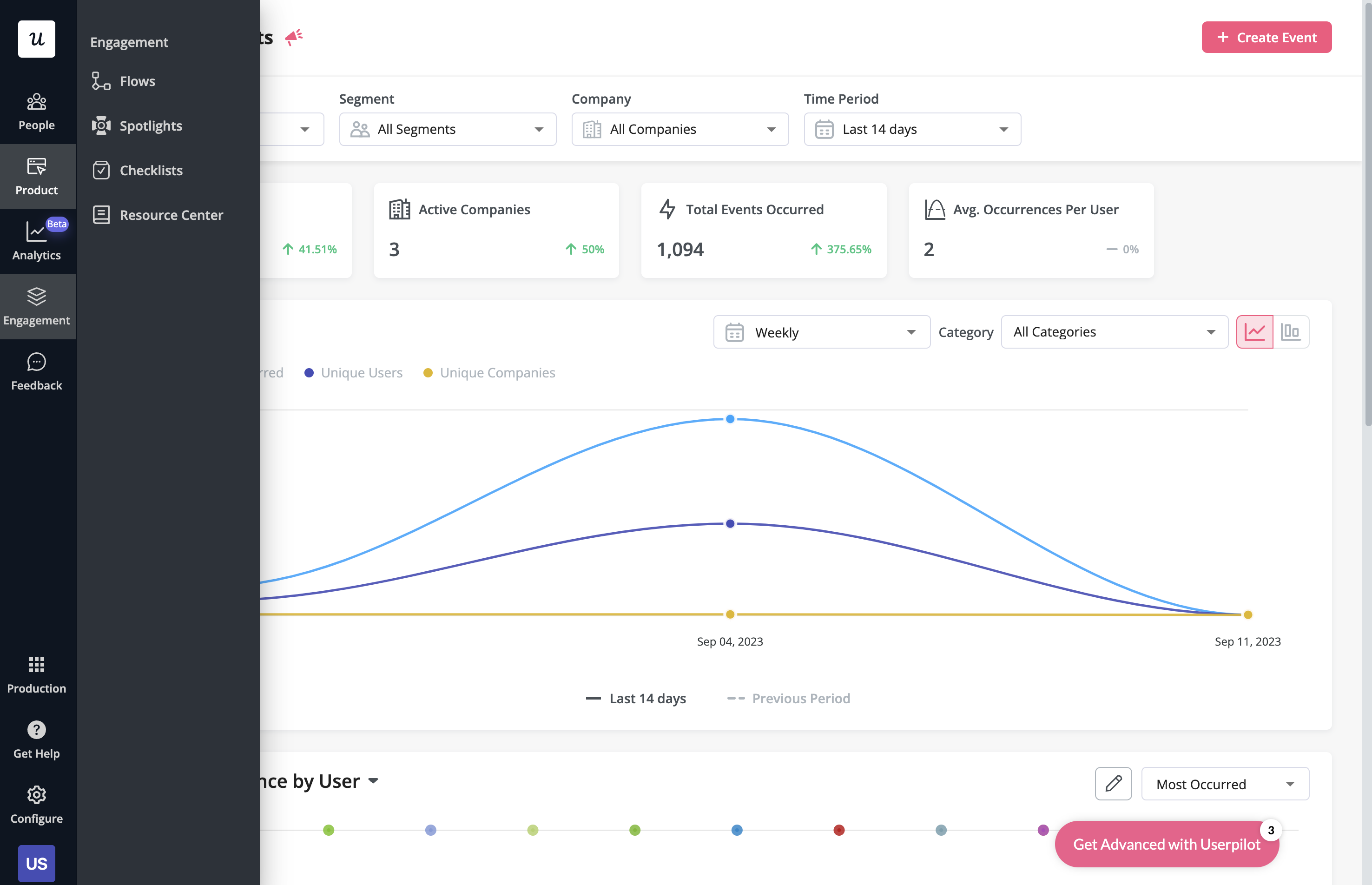
With Userpilot, you’ll be able to track both product usage and user behavior to get a holistic view of how customers use your product — which will guide future development, improve the user experience, and inform your growth efforts.
Pros of Userpilot
As a full-suite digital adoption platform, Userpilot has all the features you need to onboard users, track analytics, and gather feedback from customers without writing a single line of code. Here are a few pros of using Userpilot as your product growth solution:
- No-code builder: Userpilot’s Chrome extension lets you build flows, add UI elements, and tag features without writing a single line of code.
- UI patterns: There are plenty of UI patterns to choose from when using Userpilot, such as hotspots, tooltips, banners, slideouts, modals, and more!
- Startup-friendly: Userpilot’s entry-level plan gives you access to all available UI patterns so you can hit the ground running.
- Walkthroughs and flows: Build engaging interactive walkthroughs and personalized onboarding flows that target specific segments of your user base.
- Self-service support: Build an in-app resource center to help users solve problems, customize its appearance to align it with your brand, and insert various types of content (videos, flows, or chatbots) to keep your customers satisfied.
- A/B testing: Userpilot’s built-in A/B testing capabilities will help you split-test flows, iterate on the best-performing variants, and continually optimize based on user behavior.
- Feedback collection: Userpilot has built-in NPS surveys with its own unified analytics dashboard and response tagging to help you retarget users. There are other survey types to choose from and you can even create your own custom survey.
- Survey templates: There are 14 survey templates to choose from so you can gather feedback on specific features or run customer satisfaction benchmarking surveys like CSAT and CES.
- Advanced analytics: Userpilot lets you analyze product usage data, monitor engagement on all in-app flows, and use the data to create user segments that are based on behaviors instead of demographics.
- Event tracking: Userpilot’s no-code event tracking lets you tag UI interactions (hovers, clicks, or form fills) and group them into a custom event that reflects feature usage.
- Third-party integrations: Userpilot has built-in integrations with tools like Amplitude, Mixpanel, Kissmetrics, Segment, Heap, HubSpot, Intercom, Google Analytics, and Google Tag Manager so you can share data between all the solutions in your tech stack.
Cons of Userpilot
Of course, no tool is perfect and there are a few cons to consider before choosing Userpilot as your user onboarding or product growth solution:
- Employee onboarding: Currently, Userpilot only supports in-app customer onboarding.
- Freemium plan: There’s no freemium Userpilot plan so those bootstrapping their startup and need sub-$100 solutions should consider more affordable onboarding platforms like UserGuiding or Product Fruits.
Conclusion
Hopefully, this post helped you decide whether Appcues or Intercom is more appropriate for your company. As you can see – both have many upsides and downsides.
Undeniably, Userpilot provides a better value for money and is a better choice for a mid-market SaaS, especially when it comes to user onboarding and user feedback.
If you’re interested in finding more, book a demo with our team here!
Try Userpilot – The best User Onboarding solution for SaaS


